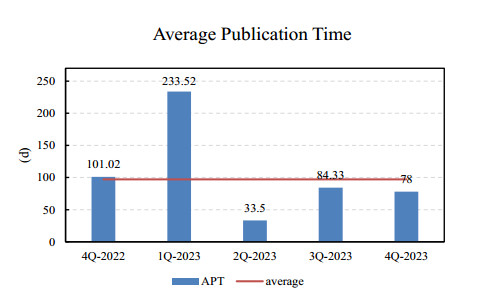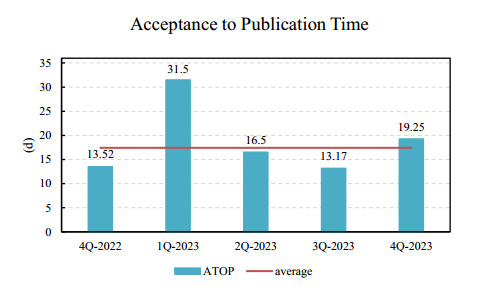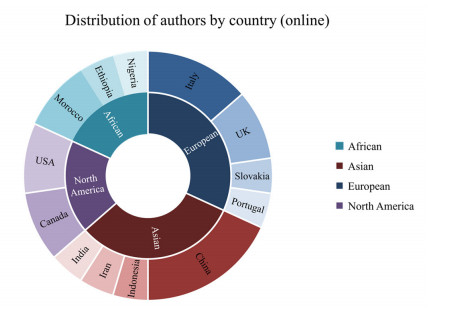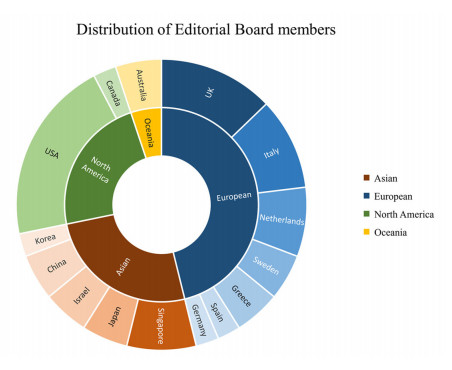1.
Introduction
In 2022, AIMS Press launched a journal focused on urban resilience, called Urban Resilience and Sustainability. The journal began accepting submissions in 2023 and in the past year, it received 42 submissions. Of those, 20 were submitted online, 9 were rejected, and 9 were withdrawn—data from the online submission system.
It is also actively expanding its editorial board to include several outstanding scholars. Next, journal development, manuscript processing, and future perspectives will be presented to share URS's work and development this year.
2.
Manuscript processing
This part includes the processing time for each stage of the manuscript, the cycle time for the manuscript to be online, and the distribution of authors.
The 20 manuscripts put online include two reviews and one editorial, which generally have a shorter processing cycle than research papers.
2.1. Manuscript processing time
The manuscript processing time consists of three indicators of measurement, which are: average publication time (APT), submission to first decision time (TFD), and acceptance to publication time (ATOP). Each indicator is also quantified on annual and quarterly time scales.
Based on the ATP, journals typically begin receiving and processing manuscripts towards the end of 2022. The initial stages of the process can be challenging, resulting in a longer average publication cycle for manuscripts. Still, the pace of publication gradually accelerates after 1Q.
The average TFD value is 69.3 days, and the review cycle is 14 days, which remains average except for the first quarter, which pulls down the average value.
This section with an average value of 17.3 days, indicates the average time from manuscript acceptance to launch, usually 10 days, which is influenced by the speed of the typesetting editor, the speed of the English editor's review, and the author's cooperation.
2.2. Distribution of countries
The geographic distribution of the author group as a reflection of the attractiveness of the journal, is a broad and strong group that can promote citation of the journal and allow it to grow and flourish.
The Sunburst Chart shows that the majority of authors of URS online manuscripts in 2023 are from Asia and Europe, with Africa following closely behind. The Americas have the fewest number of authors. Notably, Italian, Chinese, and British authors are well represented. European authors accounted for 25% of the published manuscripts.
3.
Journal development
3.1. Editorial board countries and regions
URS currently has 39 editorial board members from 15 countries on four continents. Twenty-five of them are new this year. Currently, 46% of editorial board members are from European countries, with the United Kingdom and Italy having the highest number of editorial board members.
3.2. Article metrics
The table shows the top ten manuscripts in terms of downloads and views. This will be a motivation for the future promotion of journals and to help them get into the desired databases as early as possible. Data from journal homepage as of December 20, 2023.
3.3. Special issues
Four special issues were constructed for URS 2023, with the most highly submitted special issue having 9 papers, which is 21% of the total number of submissions, and 5 final online, which is 25% of the number of online papers. The two new special issues for the second half of the year are still working on submissions.
4.
Summary and perspective
4.1. Summary
It is always said that everything is difficult at the beginning. But after the difficulties, there will be a new turnaround, for the journal and the editorial board. In 2023 URS received 42 manuscripts, put 20 online, founded 4 special issues, and added 25 new editorial board members.
4.2. perspective
Regarding the current problems, what needs to be paid attention to in the following development: 1. Increase the publicizing of journals to further absorb the high-quality papers; 2. Improve the processing speed of manuscripts and strictly control the quality of manuscripts; 3. Make full preparations for entering the database; 4. Continued enlargement of the Editorial Board.
















 DownLoad:
DownLoad: